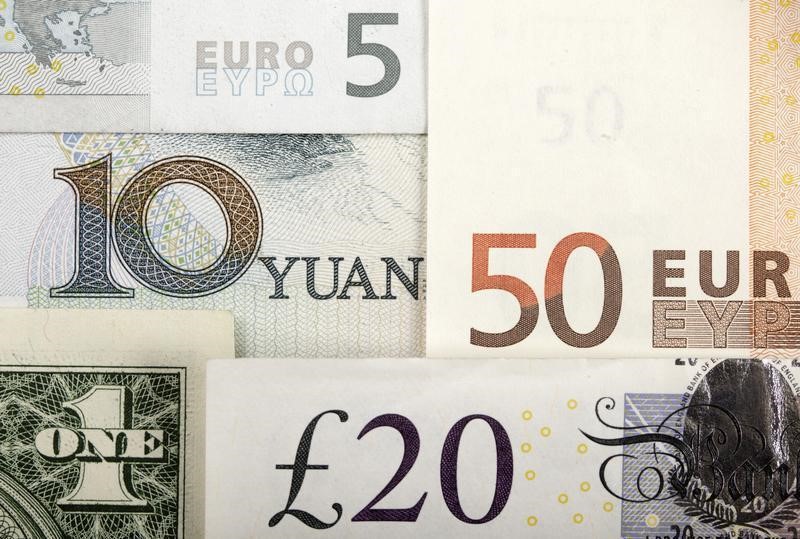* Indonesian rupiah at over 1-month low
* Taiwan dollar, Philippine peso strengthen
* Thai economy may grow less than 2% this year
(Adds text, updates prices)
By Shriya Ramakrishnan
Feb 13 (Reuters) - Most emerging Asian currencies weakened
on Thursday as a surge in the number of new coronavirus cases
dampened risk sentiment, prompting a flight to safe-haven
assets.
The Chinese province at the epicentre of the epidemic,
Hubei, reported a record rise in the death toll and health
experts warned that it could worsen before getting better.
The offshore yuan CNH=D3 and onshore yuan CNY=CFXS slid
about 0.2% each above the 6.98 level. Analysts called it a
knee-jerk reaction to the new numbers on infections and death in
China.
Asian currencies have responded to the virus outbreak
differently. Export-focused currencies with greater
trade-linkages to China have weakened substantially, with the
Thai baht THB=TH dropping 4.1% and Singapore dollar SGD=
slipping 3.2% so far this year.
However, high-yielding currencies and those perceived to be
relatively insulated from economic shocks have benefited, with
the Indonesian rupiah IDR= and Philippine peso PHP= fairly
resilient this year.
The Singapore dollar weakened 0.2% on the day, while the
baht dipped slightly.
A senior central bank official said on Thursday Thailand's
economy may grow by less than 2% this year. The S. Korean won KRW=KFTC depreciated 0.2%, while the
Malaysian ringgit MYR= edged down.
The Indian rupee INR= traded 0.2% lower. Data on Wednesday
showed the country's annual retail inflation accelerated to its
highest level in nearly six years, while industrial output
unexpectedly contracted. The Indonesian rupiah IDR= weakened 0.2% to its lowest
level in more than a month. It is, however, the top performing
currency so far this year.
"From a growth perspective India has kind of lagged and you
need an emerging economy of substantial size and growth
potential and still offering decent yields. So, the IDR becomes
an obvious alternative," said Mahesh Sethuraman, deputy head of
global sales trading at Saxo Capital Markets.
"If risk-on assets globally are down, then we may see some
IDR weakness which is more structural."
The Taiwan dollar TWD=TP gained as much as 0.2%, finding
some support from the government's plans to spend $2 billion to
help cushion the impact on the economy from the coronavirus.
PESO
The Philippine peso strengthened as much as 0.3% against the
U.S. dollar.
"The peso has been the least affected in this virus spread
in Asia so the indirect flight of capital from THB to PHP is
logical. Given that tourism from China is such a substantial
part of Thailand's revenue, the baht has got some lengths to go
in terms of weakness," Sethuraman said.
Earlier this week, Fitch Ratings upgraded the Philippines'
outlook to "positive" from "stable" and said it expects growth
to accelerate in 2020 and 2021 on the back of strong private
consumption and rising infrastructure investment. VS U.S. DOLLAR
Change on the day at 0615 GMT
Currency Latest bid Previous day Pct Move
Japan yen 109.810 110.08 +0.25
Sing dlr 1.388 1.3861 -0.17
Taiwan dlr 29.996 30.032 +0.12
Korean won 1182.000 1179.5 -0.21
Baht 31.180 31.14 -0.13
Peso 50.452 50.54 +0.17
Rupiah 13685.000 13655 -0.22
Rupee 71.473 71.35 -0.17
Ringgit 4.140 4.137 -0.07
Yuan 6.984 6.9718 -0.18
Change so far in 2020
Currency Latest bid End 2019 Pct Move
Japan yen 109.810 108.61 -1.09
Sing dlr 1.388 1.3444 -3.17
Taiwan dlr 29.996 30.106 +0.37
Korean won 1182.000 1156.40 -2.17
Baht 31.180 29.91 -4.07
Peso 50.452 50.65 +0.39
Rupiah 13685.000 13880 +1.42
Rupee 71.473 71.38 -0.13
Ringgit 4.140 4.0890 -1.23
Yuan 6.984 6.9632 -0.30
